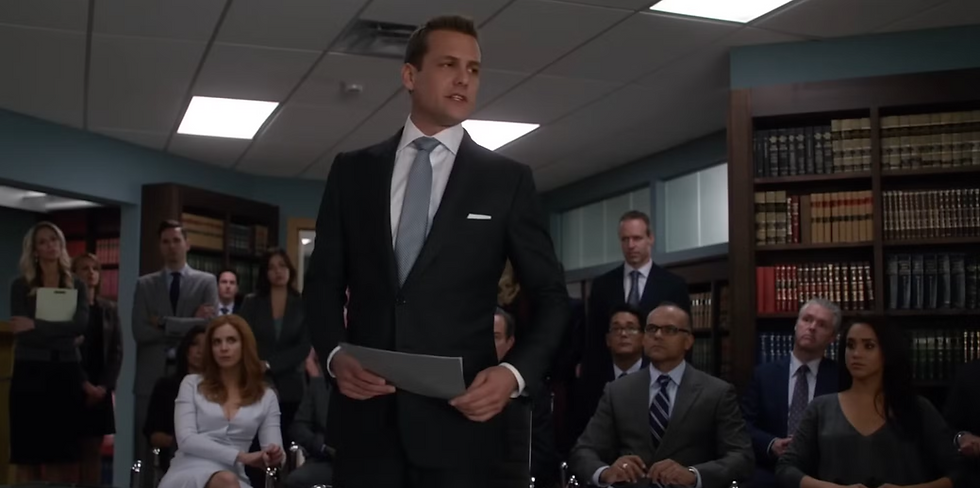INFAMOUS: Suits and Its Depiction of Law
- Yasmin Sudarsanam
- Jan 11
- 4 min read
The recent surge in popularity of Suits on Netflix has reignited discussions about its portrayal of the legal world. With its high-stakes drama, complex characters, and glamorous depiction of corporate law, Suits has captivated millions of viewers. But how accurate is it? Does it reflect the realities of practicing law, or is it merely a dramatized fantasy? Today, we’ll examine the show’s depiction of legal cases, the politics of big law firms, and the portrayal of courtroom dynamics to assess the balance between fact and fiction that went into creating this popular television show.
One of the compelling aspects of Suits is its incorporation of legal disputes that resonate with real-world cases. From insider trading and corporate mergers to intellectual property battles, many storylines seem to draw inspiration from actual legal scenarios. For example, some episodes echo high-profile cases such as the Martha Stewart insider trading case or disputes over tech patents akin to Apple v. Samsung. While the show often simplifies and condenses these cases for dramatic effect, the underlying legal conflicts remain based in truth.
Aaron Korsh, the creator of Suits, has acknowledged in interviews that he consulted legal experts to ensure the legal issues portrayed in the show had a basis in reality. However, the creative team also took liberties to heighten the drama, such as fast-tracking legal proceedings or adding unexpected twists that rarely occur in real courtrooms.

A hallmark of Suits is its depiction of the cutthroat politics within top law firms. The show’s central firm, initially called Pearson Hardman, is rife with power struggles, merger battles, and conflicts over coveted positions like managing partner and name partner. While the portrayal is undeniably dramatized, it’s not entirely distinct from reality. In real life, law firms are competitive environments, especially among “Big Law” firms. Battles over lateral hires, client acquisitions, and firm mergers are common. Recent examples include the 2020 merger between Dentons and Salt Lake City’s Durham Jones & Pinegar, which highlighted the complexities of integrating firm cultures. Similarly, partner compensation disputes and disagreements over leadership transitions occasionally make headlines, though they’re rarely as theatrical as Suits suggests. However, most real-world law firms emphasize teamwork and professionalism. The high-stakes rivalries seen on Suits are exaggerated for dramatic purposes. In reality, the majority of firms invest heavily in fostering collaborative cultures to attract and retain top talent.
Courtroom scenes in Suits are among the most dramatic moments of the series. Characters engage in heated confrontations, deliver passionate monologues, and unveil game-changing evidence at the last minute. While these scenes make for entertaining television, they are far from an accurate reflection of real-life legal practice. In reality, courtroom proceedings are methodical and governed by strict and long-standing rules. Most legal battles are resolved long before reaching trial through negotiations, settlements, or pre-trial motions. The discovery process, which involves the exchange of evidence between parties, is a lengthy and meticulous phase rarely shown in the series. Additionally, surprise revelations are almost nonexistent in real courtrooms, as both sides are required to disclose evidence in advance. Despite these inaccuracies, Suits succeeds in capturing the emotional intensity of high-stakes litigation.
Suits glamorizes the lifestyle of corporate lawyers, showcasing designer suits, luxurious offices, and high-profile clients. While this image has a basis in reality, it overlooks the grueling nature of legal work. Big Law attorneys often face demanding schedules, with billable hour requirements that can exceed 2,000 hours per year. The mental health toll of such a high-pressure environment is well-documented, with studies highlighting elevated rates of stress and burnout among lawyers. The show also touches on issues of gender and diversity in the legal profession. In real life, initiatives to address these challenges, such as diversity and inclusion programs, are becoming increasingly common within law firms.

While Suits invents its dramatic scenarios, the legal world has its fair share of real-life intrigue. High-profile corporate cases, such as the 2018 AT&T-Time Warner merger, showcased the strategic maneuvering and legal expertise required in antitrust law. Similarly, intellectual property disputes, like those involving major tech companies, highlight the stakes involved in protecting innovation. On the law firm side, recent mergers and acquisitions demonstrate the competitive nature of the industry. For example, the 2020 combination of Hogan Lovells with a South African firm underscored the global reach and ambition of top firms. These real-world events mirror the power dynamics and high stakes portrayed in Suits.
Suits offers a captivating glimpse into the world of corporate law. While its portrayal of cases, law firm politics, and courtroom drama is often exaggerated, the show’s popularity highlights the public’s fascination with the legal profession. For aspiring lawyers and casual viewers alike, Suits serves as both an entertaining drama and a starting point for deeper exploration of the law’s real-life intricacies. By examining the intersection of fiction and reality, we can gain a better understanding of how Suits shapes perceptions of the legal world.
Feel free to leave your thoughts, opinions, and questions below! If you want to see more cases similar to this one, like this post to let me know!
Thank you to Arthur for suggesting this case; if you have a specific case you would like me to cover, please leave it in the suggestion box!
Sources:




Comments